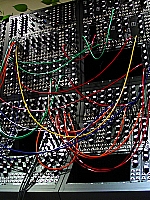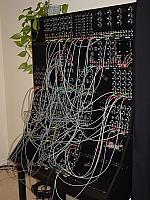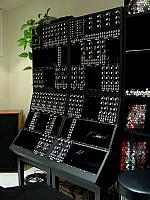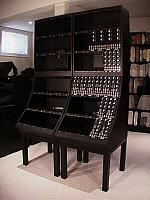
|
| January 2006 |

|
| October 2002 |

|
| May 2002 |

|
| November 2001 |
Last updated: January 8, 2006
|
Who Is Darmok?
Darmok is the name of my MOTM based modular synthesizer (shown at left). Contact me if you have any queries regarding Darmok.
As of January 8, 2006, the module complement consists of:
| 2 | MOTM-101 | Noise Generator, S & H | Synthesis Technology |
| 2 | MOTM-110 | Ring Mod & VCA | Synthesis Technology |
| 2 | MOTM-120 | Sub-Octave Multiplexer with DB-120 | Synthesis Technology |
| 2 | MOTM-190 | Voltage-Controlled Amplifier & Ring Mod | Synthesis Technology |
| 8 | MOTM-300 | Voltage-Controlled Oscillator | Synthesis Technology |
| 4 | MOTM-310 | Voltage-Controlled Oscillator | Synthesis Technology |
| 4 | MOTM-320 | Voltage-Controlled LFO with DB-320 | Synthesis Technology |
| 2 | MOTM-380 | Quad LFO | Synthesis Technology |
| 2 | MOTM-410 | Triple Resonant Filter | Synthesis Technology |
| 2 | MOTM-420 | Voltage-Controlled Filter | Synthesis Technology |
| 2 | MOTM-440 | Discrete OTA Voltage-Controlled Filter | Synthesis Technology |
| 2 | MOTM-480 | CS-80 Style Resonant Voltage-Controlled Filter | Synthesis Technology |
| 2 | MOTM-510 | Wave Warper | Synthesis Technology |
| 2 | MOTM-700 | Dual Voltage-Controlled Router | Synthesis Technology |
| 4 | MOTM-800 | ADSR Envelope Generator with DB-800 | Synthesis Technology |
| 2 | MOTM-820 | Voltage-Controlled Lag Processor | Synthesis Technology |
| 4 | MOTM-830 | Mixer | Synthesis Technology |
| 2 | MOTM-850 | Pedal Interface | Synthesis Technology |
| 6 | MOTM-900 | Power Supply | Synthesis Technology |
| 12 | MOTM-910 | Cascaded Multiple Panel | Synthesis Technology |
| 6 | TLN-132 | Dual Voltage Controlled Amplifier | The Tellun Corporation |
| 2 | TLN-156 | Neural Agonizer | The Tellun Corporation |
| 2 | TLN-428 | Voltage Controlled State Variable Filter | The Tellun Corporation |
| 2 | TLN-442 | Voltage Controlled Lowpass Filter | The Tellun Corporation |
| 1 | TLN-854 | Sword of Kahless | The Tellun Corporation |
| 1 | TLN-904 | Veeblefetzer | The Tellun Corporation |
| 2 | JLH-822 | Interval Switch | Larry Hendry |
| 2 | OMS-201 | WaveFolder | Oakley Sound Systems |
| 2 | OMS-410 | Companion Module for MOTM-410 | Oakley Sound Systems |
| 2 | OMS-820 | Companion Module for MOTM-820 | Oakley Sound Systems |
| 4 | OMS-902 | MultiMix with Mods | Oakley Sound Systems |
| 2 | Equinoxe | Voltage-Controlled Phaser | Oakley Sound Systems |
| 4 | MW2090 | Mini Wave with Expander and JLH-2090CV | Blacet Research / Wiard Synthesizer |
| 2 | TM2050 | Time Machine | Blacet Research |
| 2 | DSC2000 | Dark Star Chaos | Blacet Research |
| 4 | UEG | Universal Event Generator | Encore Electronics |
| 2 | Frequency Shifter | Frequency Shifter | Encore Electronics |
With more than a dozen other modules in various stages of completion (not shown in pictures or included in the list above).
The modules from The Tellun Corporation, Oakley Sound Systems, Blacet Research, and Larry Hendry feature Stooge Panels.
|
Cabinet Design
Darmok consists of six cabinets: three lower cabinets and three upper cabinets. Each cabinet is constructed from 3/4" MDF, screwed together and painted black. Larry Hendry's flat rails are used to attach the modules to the cabinet. The flat rails are attached to 1/2" pieces of MDF that are also painted black. Each cabinet can house 36U of modules in the MOTM format. The lower cabinets have three rows (each 12U wide) that are angled 45, 30, and 15 degrees from vertical. The upper cabinets also have three rows (each 12U wide) but are not angled. Each cabinet is powered by its own MOTM-900 power supply mounted on the back of the cabinet. The lower cabinets use a single MOTM-960 power distribution board to provide 21 connection points. The upper cabinets use two MOTM-900-PCB power distribution boards to provide 24 connection points.
One of the lower cabinets has an additional +5V power supply added in parallel with the MOTM-900 power supply. These two power supplies share the same power switch on the MOTM-900 and are hooked up to an MOTM-990 power distribution board. This cabinet is intended to house modules that require +/-15V and +5V using the newer 6-pin power connector. The fuse in the MOTM-900 power switch has been replaced with a larger (dummy) fuse because it has to feed both power supplies. Each power power supply then has it's own fuse after the power switch. The power distribution board on the MOTM-900 has been replaced with a piece of plexiglass and a terminal block to facilitate rewiring the two power supplies to the MOTM-900 power switch, the fuses, and to the MOTM-990 power distribution board. Pictures can be found here.
Cabinet size and layout were chosen based on the following criteria:
- The flat rails are 6U wide, so each row had to be a multiple of this width.
- I wanted to use the standard MOTM-900 power supply for each cabinet.
- The MOTM-960 power distribution board has 21 connectors and the MOTM-900-PCB power distribution board has 12 connectors.
- The power distribution cable that ships with MOTM modules is 20" long.
- Most modules are 2U wide.
- I have more vertical space than horizontal space in my studio.
- I don't gig, but I still have to be able to move each cabinet by myself.
I put together numerous cabinet layouts, each with a variety of modules, using a spreadsheet to determine the number of power connectors needed and the power supply loading. The optimal solution was a three row by 12U design that has the following features:
- Each row is a multiple of the flat rail length.
- Power supply loading varies between 60% and 80%, depending on the module complement.
- The number of power connectors required varies between 18 and 22.
- A centrally mounted power distribution board can reach each module using the 20" cable that ships with MOTM modules.
- It fits in my studio.
- I can lift it.
|
Sound Samples
Darmok can be heard in the following places:
|
|



